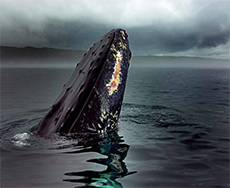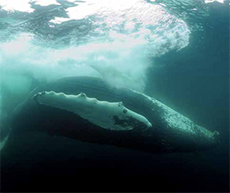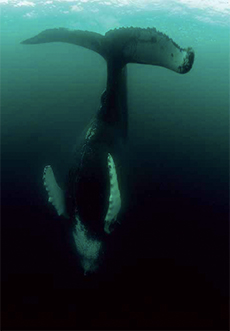




| Home | Features | Club Nights | Underwater Pics | Feedback | Non-Celebrity Diver | Events | 8 August 2025 |
| Blog | Archive | Medical FAQs | Competitions | Travel Offers | The Crew | Contact Us | MDC | LDC |

|

|
 
 |
   ISSUE 15 ARCHIVE - THE SEADOC INVESTIGATES: WHALESDr John CarlinMy wife asked me what I would be writing about next and I thought I would write about one of the largest animals I have ever seen – a whale. From Moby Dick to modern day conservation efforts, people’s perception of whales have changed a lot in the past 100 years.Whales belong to the order Cetacea which comes from the ancient Greek word ‘ketos’ for ‘huge fish’ or ‘sea monster’. All cetaceans are mammals and not fish as they are warm blooded, breathe using lungs, give birth to live young and feed with milk produced by the mother. Fossils from a region in Pakistan have helped to determine the origin of cetaceans that evolved from an ancestral animal which also gave rise to deer, camels, cows, pigs and hippos. Recent DNA molecular analyses have shown that hippos are the closest relation to whales and that they shared a semi-aquatic ancestor around 60 million years ago. The title for the biggest animal to ever exist is held by the blue whale. A few of the biggest dinosaurs may have been longer than the blue whale, but none could compare to the its actual body size. The longest blue whale on record was 33 metres and the heaviest was 190 tons. So why are whales so big? People believe that this is because there was relatively more food in the ocean than on land and that they were free from the constraints of gravity and legs. Scientists call them ‘obligate marine mammals’ as they cannot survive on land (their internal organs would be crushed by their own weight) unlike animals such as seals and walruses. Cetaceans are the most fully adapted mammals to marine life and the millions of years of evolution have shaped their bodies to become tapered. Their tail has evolved in to a pair of horizontal propeller-like flukes which can be seen in the classic photograph which accompanies this article. Part of the evolutionary streamlining process resulted in the fore limbs (arms) becoming flippers and the hind limbs (legs) effectively disappearing. Did you know that the fastest whale, the killer whale (orca), can reach speeds of 50 kilometres an hour when hunting? Over time they lost the bulk of their fur (some tiny hairs remain around the jaw region) to reduce drag in the water. To compensate for the loss of heat insulation provided by the fur, they developed a layer of fat called ‘blubber’ to protect them. Whale blubber is oil rich and covers the whole body apart from the appendages of the whale. It can comprise of up to 50% of the body weight and can vary from several inches to over a foot thick on larger species of whale. The thickness of the blubber isn’t directly related to warmth. The insulation properties actually come from the concentration of water and lipids (types of fat molecules) which can vary. Blubber is also used by whales as an energy store and this is why it has formed an important part of the diet for Inuit people for its high energy value. These properties of blubber were one of the main driving forces behind the whaling trade, where the blubber was collected from whales and made into oil to be used for fuel, wax, soap and cosmetics. There are two types of whale. The Odontoceti (toothed whales) such as the sperm whale and the Mysticeti (baleen whales) such as the blue whale. Whilst toothed whales feed mainly on a mixture of fish, squid and plankton, it is actually the filter feeding baleen whales who are bigger in size with the exception of the sperm whale. This may surprise some people when they consider the tiny organisms filtered from the seawater that the baleen whales eat. Did you know that despite its size, a blue whale cannot swallow anything larger than a beach ball? The filtering system for baleen whales is made of baleen plates with baleen hair bristles made of keratin (the same stuff found in our own nails and hair) which retains the small micro-organisms as seawater is pushed through them. The blue whale needs 1.5 million kilocalories a day to survive and can consume over 3,000 kilograms of krill (shrimp-like marine crustaceans) every day. Baleen used to be used to stiffen corsets, as parasol ribs and to crease paper – thankfully we have found alternatives for this. Did you know that a blue whale’s tongue is the same size as an African Elephant? Scientists believe whales have evolved their characteristic ‘blow holes’ at the top of their heads to make breathing in rough seas easier. The blow holes remain closed until they break the surface and stale warm air is ‘explosively’ exhaled as a cloud of steam as it condenses with the colder air. The exhaled air is often called a ‘blow’ or ‘spout’ and can be characteristic to different species by the shape, angle and height. Toothed whales, apart from having teeth, differ from the baleen whales by only having a single blow hole whereas baleen whales have two which causes a ‘v-shaped blow’. Whales can fill their lungs with fresh air in less than two seconds despite the fact that they inhale more than 3,000 times the amount of air our own human lungs can hold – now that is impressive. Did you know that a single breath from a blue whale is enough to inflate 2,000 balloons? Whales can remain underwater for much longer than other mammals and this time can vary from seven to thirty minutes depending on the size of the species. Now as scuba divers and free divers we will have learnt about the mammalian diving reflex (bradycardia) which optimises the body’s respiration rate to help us stay underwater for longer whilst holding our breath. Now figures seem to vary but the best that humans can do on average is to reduce their heart rate to 40% whilst whales can reduce their rate by an amazing 80-85%. Another key difference is with lung volume. Now, you may think that whilst whales are so great at staying underwater, they must have massive lungs but you would be wrong. Proportionally the lung volume of whales is only about half of that found in land mammals. So, how do they do it? Well their lungs are much more efficient. Whereas we humans only used about 15% of the air we breathe (tidal volume), whales kick ass by being able to use 85-90% of the air they breathe in. Whales have bigger red blood cells than humans and proportionally more of them, which mean they are better adapted to making use of the oxygen from the air they have just inhaled. With all this extra oxygen in their blood stream, whales are able to store it in their muscle tissue, using a substance called myoglobin. As humans, we also have myoglobin, but just not in the amount or concentration that whales have. Myoglobin is responsible for the dark colouration seen in muscle tissue (that is why you get dark meat) and the sperm whale, the deep diving champion capable of diving to depths of over 3,000 metres, has so much myoglobin that its flesh almost seems black in colour. Did you know that the size of a blue whale’s heart is the same as a volkswagen Beetle and the major artery is big enough for a small child to climb through? Scientists believe that whilst whales could suffer mild decompression sickness (DCS) if they surface too quickly, it is largely avoided by the fact they hold their breath rather than breathing a continuous supply of air and absorbing additional nitrogen like a scuba diver. This, and the breath-holding adaptations they have evolved, including environmental behaviour like ascending slowly and pausing frequently (just like a good Scuba diver) help to reduce the risk of DCS. Toothed whales use sound waves for echolocation to target prey – they had sonar before we did. This can help them to determine the size, shape, speed and direction of their potential meal. Baleen whales also use echolocation as the majority of the ocean exists in darkness and blue whales have the loudest voice of any animal on earth (188 decibels). Whales use sound for long range communication, as the sound waves emitted can travel for many kilometres underwater and can be used to call an assembly, identify mates and as a greeting or threat. These sounds appear to our ears as a series of low moans, grunts, thumps and high frequency chirps or whistles. When I was working in Indonesia we were tracking a pod of pilot whales and it was amazing to listen to them using an underwater microphone. Humpback whales are famous for their songs which are commonly included on relaxing, sleep-inducing CD’s for insomniacs. The whale songs are often used as feeding or mating calls for the opposite sex and can be different within a species depending on the area that they are from. These songs can last up to thirty minutes and they will often repeat them for several hours or sometimes even days. Whales also communicate posturing with their bodies, slapping their tails and breaching. Forceful ‘blows or spouts’ and pectoral slapping can indicate arousal, excitement and aggression. Breaching is where the whale lunges upwards and exposes its body out of the water. If you have ever been lucky enough to go on a whale watching tour this can provide an amazing opportunity to get some great action shots. Whales tend to breach when they are together in groups and it is thought that it is used as a way of establishing dominance in a group, impressing peers/potential mates and as a way to signal distress. Some scientists believe it may be a way of ridding parasites from the skin as well. Spyhopping is where a whale rises and holds it head partially out of the water just like a human treading water to view something at or nearby the surface. Spyhopping is done not by swimming but by buoyancy control and positioning of their pectoral fins. It is more controlled and slower than a breach and can last for several minutes if the whale is sufficiently inquisitive enough. Whales are known slapping their tails on the surface, and is thought as a practice called ‘lobtailing’ which creates a big noise and splash. Whilst the heavy slaps can be heard up to several hundreds of metres away and it is thought to be a sign of showing off or aggression, it is not as effective as other forms of vocal communication. Some people suggest that lobtailing in humpback whales is used as a means of foraging with the theory that the loud noise scares the fish into a tighter school making them easier to hunt. The hunting of whales has been documented back to 6,000 BC, but it wasn’t until the 17th century that it became more organised, resulting in what is known as ‘whale harvesting’ and by the 20th century there were active whaling industries and ‘factory’ ships. In the late 1930’s more than 50,000 whales were killed each year resulting in devastating consequences on species numbers. In the 1970’s a global anti-whaling movement was created with the hope of saving some species of whale which were being hunted to extinction. In 1972 a 10 year whaling moratorium (ban on commercial whaling) was introduced by the International Whaling Commission to allow species to recover. The moratorium continues to apply, however whilst it prevents commercial whaling, whaling for scientific research and aboriginal subsistence is permitted, which some conservation groups believe is being abused by certain countries. This has resulted in conservation groups such as Greenpeace and the more pro-active Sea Shepherd group raising awareness and actively trying to prevent the unnecessary and barbaric slaughter of these amazing animals. The cycle of greed behind the whaling industry has driven one whale species after another towards the brink of extinction. Statistics show that blue whales are currently less than 1 percent of their original abundance. We must raise awareness before it is too late. If you want to find out how you can help save them, please don’t hesitate to contact me and remember our world would be a poorer place without these magnificent and record-breaking creatures. Previous article « Dry Sharm Dos Next article » Cooking the Catch: Crisp Skin Salmon with Spiced Lentils Back to Issue 15 Index |